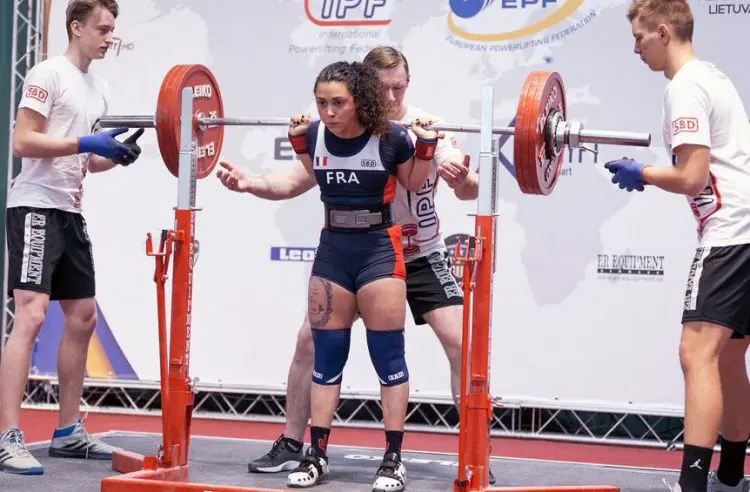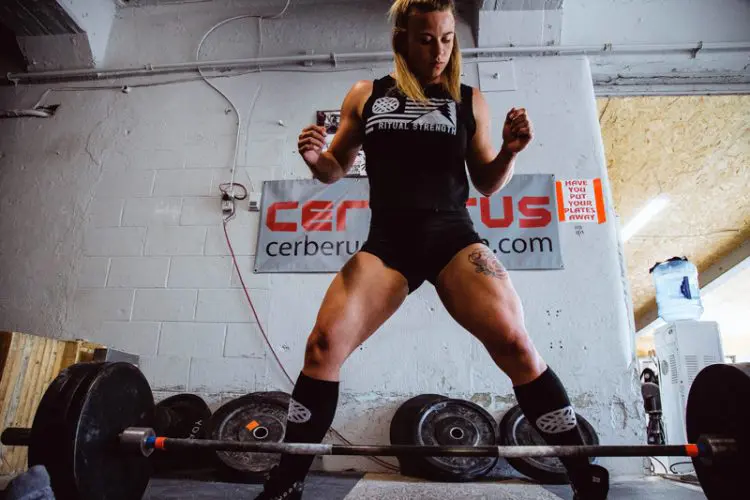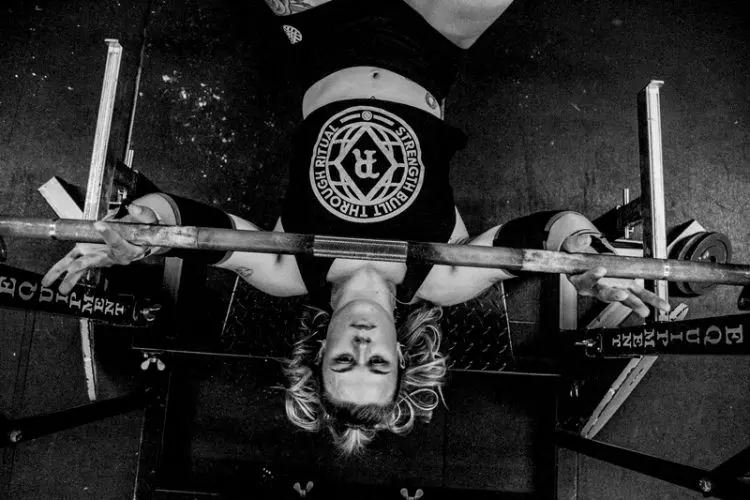Long gone are the days where strength training and sport was male-dominated. In fact, it’s thought that the number of women participating in powerlifting has more than doubled since 2015!
Although the idea of starting powerlifting may be a little daunting, growing in strength and confidence is highly rewarding.
To help you make the best start possible, this article will highlight eight steps that you should consider to familiarize yourself with the sport and best prepare you for entering a powerlifting competition.
The Eight Steps To Powerlifting
The following eight steps will ensure that you understand the demands of powerlifting before embarking on your quest to become the strongest woman in your weight class.
1) Understand The Sport Of Powerlifting
Before you begin your training, it’s crucial that you understand powerlifting, the rules, and how competitions work.
Level Up Your Fitness: Join our 💪 strong community in Fitness Volt Newsletter. Get daily inspiration, expert-backed workouts, nutrition tips, the latest in strength sports, and the support you need to reach your goals. Subscribe for free!
Doing so will lay the groundwork for entering a powerlifting competition as you will have a better idea of what to expect when it comes around.
If you are programming your own training, failing to understand the demands of the sport may cause you to train in a sub-optimal manner.
Powerlifting is a sport that assesses your maximal strength through three different lifts – the deadlift, squat, and bench press.
During meets, you will be given three attempts with each movement to lift as much weight as possible. Your best lifts will be recorded and tallied.
For example, let’s say that you lift 160lbs for the deadlift, 130lbs for the squat, and 90lbs for the bench, your accumulative total will be 330lbs.
The athlete who has lifted the most accumulated weight will be crowned the champion.
There are a number of other factors that you must know about powerlifting. Powerlifting is a weight classified sport. This means that you will be placed in a group depending on your body weight.
This is done to even the playing field, otherwise heavier lifters would have a substantial advantage over lighter lifters (1).
There are also many different powerlifting federations all of which have their own set of rules and regulations regarding competitions, attire, drug testing, and weigh-ins.
If you want to perform competently and avoid being disqualified from competitions, you must familiarize yourself with the rules of your chosen powerlifting federation.
If you don’t know which federation to chose, check out choosing a Powerlifting Federation.
2) Experience A Powerlifting Meet
Once you have begun to grasp the sport of powerlifting and how competitions work, go and see it for yourself.

There are thousands of powerlifting meets hosted around the world each year. It’s likely that you don’t need to do a great amount of research or travel far to find one.
While it’s all fine and well reading about powerlifting competitions and how they work, however, attending a meet will give you a better feel for it.
By familiarizing yourself with the ins and outs of a powerlifting competition, you will certainly feel a lot more comfortable and confident when you eventually do compete.
Furthermore, you may find that attending a meet will significantly increase your motivation. It is absolutely inspiring to see athletes lift heavy weight and set new records.
Lastly, it will give you an opportunity to chat with other women within the sport and ask them any questions that you may have about their training and preparation for the competition.
Also check 6 methods to help you cut weight for powerlifting events.
3) Hire A Coach
If you are an absolute beginner to strength training, it is highly recommended that you hire a coach, preferably one with experience in powerlifting.
Doing so will ensure that you learn the correct techniques with all strength training exercises.
Research suggests that poor technique is the number one cause of injury during strength training (2). Therefore, if you aspire to get strong while remaining injury-free, your technique must be good.
This training program that you are given should be a progressive plan that will allow you to significantly enhance strength across the board and also increase your competence with the powerlifts.
Additionally, having a coach can certainly help with accountability, motivation, and support.
With so many coaches to choose from, it can be difficult to know where to begin. The first thing to do is to consider what it is you are looking for from a coach.
As mentioned, you should look to find a coach who is well-versed in powerlifting, that should go without saying.
Beyond that, you may need to consider your budget and select the service that works best for you.
Some lifters prefer to have multiple one-to-one sessions per week while others prefer less frequent sessions.
If you already have experience with strength training, online training may be a worthwhile option. Typically, online is more cost-effective than one-to-one training and involves a greater degree of independence.
4) Use A Powerlifting Program
There is no doubt that hiring a coach can be expensive and, therefore, this may not be possible for some.
However, if this is the case, fear not. There are an array of high-quality beginner powerlifting programs that you can find online.
The 5/3/1 by Jim Wendler, GreySkull LP program, GZCLP program, nSuns LP program, and Madcow 5×5, are all excellent examples of beginner powerlifting programs.
These beginner-friendly programs have all been designed to help you make the best progress possible and allow you to substantially increase the weight lifted for the deadlift, squat, and bench press.
Also a must read 12 strength training programs.
5) Schedule Your Training In
The physical training that you partake in prior to competition will ultimately determine how much weight you lift on the day.
If you want to be competitive as a powerlifter, you have to be fully committed to your training. Missing sessions or being inconsistent is not an option.
A useful way to look at your training is to view it as an appointment. Schedule your gym sessions in your diary or weekly planner like you would a dentist or doctor’s appointment.
While you may feel very motivated at the moment, there may be times where your enthusiasm starts to waver. This is totally normal – every lifter experiences this.
However, this method may help with your adherence and consistency which will keep you on track, even on the days where you don’t feel like training.
6) Learn How To Lift
Once you have done these things, it’s time to knuckle down and work hard. Initially, the focus of your training should be on learning the three powerlifts – the deadlift, squat, and bench press.
Some people pick up the techniques of these lifts fairly quickly while others may need longer to get to grips with them.
If possible, have a coach or someone with powerlifting knowledge teach you the techniques. This way you can be assured that your movement and technique is safe and effective.
The other thing to consider is that powerlifting federations have particular rules relating to the deadlift, squat, and bench press.
Therefore, it’s worthwhile having a coach check your technique to ensure that it fits the criteria and will pass when it comes to a powerlifting meet.
7) Set Powerlifting Goals
Once you have the technique down, you can then begin to plan for your first ever powerlifting competition.
This involves assessing your strength and then determining goal weights for the deadlift, squat, and bench press.
It’s important to become familiar with one-rep max testing. As the name suggests, this involves performing one rep with as much weight on the bar as possible.
This is often seen as the gold-standard of strength testing and is, therefore, something that powerlifters should use frequently (3).
Your results from your one-rep max tests can be used to calculate the appropriate amount of weight to use in your training program.
Furthermore, strength tests can also give you a rough idea of your goal weight for each lift.
Once again, this is best done under the supervision of a coach who will ensure that goal weights are realistic and actually attainable.
8) Enter A Powerlifting Competition
Once you have determined goal weights, you can then look to sign up for your first ever powerlifting competition!

When choosing an event, there are two things to consider.
Firstly, if possible, look for a local beginners powerlifting event. These events tend to be much more relaxed than large competition meets.
Entering these competitions will give you a taste of what it’s like to participate in a powerlifting competition without causing you to feel overwhelmed or stressed.
Having participated in a competition like this, you may then feel more prepared to sign up for a more competitive and advanced event.
Secondly, you need to consider the time until the event. There is no point signing up for a competition that is only a couple of weeks away as this does not give you enough time to train.
Ideally, look for an event that is anywhere between eight and twelve weeks away. This is a more appropriate timeframe as it will give you enough time to reach your goal weight for the deadlift, squat, and bench.
Final Word
Powerlifting is not just for men. There are thousands of incredible women who are building insane strength and competing at the highest levels.
While the thought of powerlifting may be a little overwhelming, following the eight steps outlined in this article will help to guide you through to your first ever competition.
References:
1- Ten Hoor, Gill A.; Plasqui, Guy; Schols, Annemie M. W. J.; Kok, Gerjo (2018-03-01). “A Benefit of Being Heavier Is Being Strong: a Cross-Sectional Study in Young Adults”. Sports Medicine – Open. 4. doi:10.1186/s40798-018-0125-4. ISSN 2199-1170. PMC 5833324. PMID 29492711. [source]
2- Saragiotto, Bruno T.; Di Pierro, Carla; Lopes, Alexandre D. (2014). “Risk factors and injury prevention in elite athletes: a descriptive study of the opinions of physical therapists, doctors and trainers”. Brazilian Journal of Physical Therapy. 18 (2): 137–143. doi:10.1590/S1413-35552012005000147. ISSN 1413-3555. PMC 4183252. PMID 24845023. [source]
3- Seo, Dong-il; Kim, Eonho; Fahs, Christopher A.; Rossow, Lindy; Young, Kaelin; Ferguson, Steven L.; Thiebaud, Robert; Sherk, Vanessa D.; Loenneke, Jeremy P.; Kim, Daeyeol; Lee, Man-ki (2012-06-01). “Reliability of the One-Repetition Maximum Test Based on Muscle Group and Gender”. Journal of Sports Science & Medicine. 11 (2): 221–225. ISSN 1303-2968. PMC 3737872. PMID 24149193. [source]










